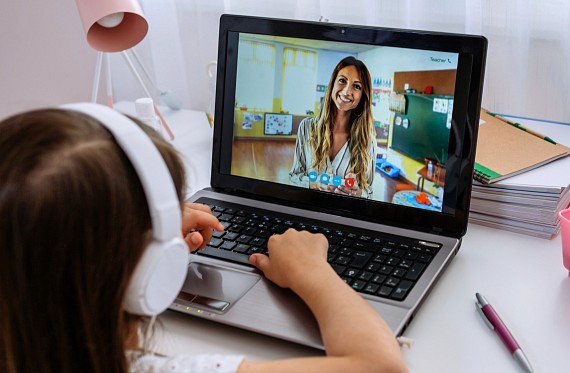Imagine this: It's a Tuesday afternoon, and I'm briefly logging into Facebook for a work-related task. Suddenly, I find myself sidetracked by a flood of notifications and memories—some cringe-worthy exchanges from more than a decade ago. This scenario might feel all too familiar to some of you, reminding us that, like our students today, we were once the first generation navigating the vast and evolving digital world.
I grew up with the internet, navigating its early challenges—from rushing home from school to speak with my friends on MSN to creating my first social media profile (and managing the online drama that comes along with it). My experiences mirror the digital hurdles my students face today, though they engage with more sophisticated technologies. Yet, my story is just one among diverse teacher experiences. We range from those who remember dial-up internet to those who embraced the internet later in their careers, reconnecting with peers and exploring new resources, to the newest generation of teachers who've never known a world without the internet. Each of our digital journeys enriches our ability to guide students through their own.
Our students are dealing with similar issues to those many of us faced (and are still facing today), yet under different circumstances. However, our 2024 Safer Internet Day findings reveal a poignant insight: 62% of secondary students feel that older generations lack the necessary understanding to assist them with online issues. This significant disconnect calls for us to bridge this gap with empathy and understanding. As educators, we are also mentors in managing online relationships, addressing cyberbullying, and cultivating healthy digital identities.
Drawing from our personal experiences with digital landscapes, we can provide unique insights and empathetic guidance to help students navigate these complex waters safely and wisely. With the Online Safety Act now updated, it’s clear that integrating these elements into our lessons isn’t just a good move—it's recommended. This act pushes us to make sure our students are savvy about the risks and know how to handle them.
But remember to avoid the ‘when I was young’ approach. We’re talking more about not forgetting what we have also lived and experienced and how we have managed things online (or not) and how it also affects our daily lives as well as theirs.

Download our assembly on the Online Safety Act to keep the conversation going at your school.
DownloadPlease complete this form to access your assemby.
While we guide our students through the digital world, it's crucial to remember that learning is reciprocal. Our students, often more attuned to the latest technologies and digital trends, can offer us fresh perspectives and insights. By maintaining an open dialogue and acknowledging that we, too, can learn from them, we foster a more inclusive and dynamic educational environment. This mutual exchange enriches our understanding and can lead to innovative approaches to digital literacy and safety. And they might just be able to give you some tips to prevent you getting home from work, crashing on the couch and doom scrolling for 3 hours.
Amid current discussions around digital boundaries, such as WhatsApp's controversial decision to lower its age limit and the UK's deliberations on smartphone restrictions for minors, we find our responsibilities as educators expanding.
While Government guidance outlines that phones should not be used at any point in the school day, we know that the reality is much harder to police. On top of that, we cannot control the content our children access outside of school hours. According to a 2019 report from Ofcom, the average 3-4-year-old spends three hours a day in front of a screen, and this number only increases as children get older. By the time they reach teenage years, children are spending a staggering 6.5 hours per day in front of screens.
And it’s not just ‘staying safe online’ that we need to think about either. More and more research is showing us how screen time is affecting our brain function, our focus and even our happiness. So it’s clear that integrating responsible online behaviour discussions into our curriculum is essential, especially as our findings show that only about 30% of secondary students would consider a digital detox.

By sharing our experiences and struggles with digital dilemmas, such as the overwhelming influence of social media on self-esteem and mental health, we make our classrooms open forums for modern challenges. These discussions are crucial, as they help build a community where teachers and students can learn from each other's experiences and grow stronger together.

Role-Playing Activities: Help students understand the emotional impact of online interactions by acting out different scenarios involving technology use.
Digital Safety Basics: Introduce games or quizzes that teach them about internet safety and privacy settings.
Art Projects: Encourage expression about their feelings on social media and technology through art, which can be discussed later as a group.

Delve into research: Switch it up so it’s not just coming from you. This playlist contains four 10-minute videos that are great for exploring screen time and addiction with the statistics to back them up
Critical Media Literacy Lessons: Encourage critical thinking about media consumption and the disparity between real life and social media portrayals.
Use role models to get the message across: Screen-time-reduction app Opal have heard from many celebs talking about how they reduced their screen time. Their Instagram is full of inspirational people spreading the message.
Digital Ethics Debates: Explore ethical dilemmas in the digital world, such as privacy and online behaviour, through structured debates.
Technology Fast Challenges: Challenge students to reduce screen time and reflect on their experiences, sharing insights in class discussions.
Reflecting on my own digital habits continually influences both my life and teaching. Which makes me wonder, what changes can we, as educators, make to enhance our digital literacy and that of our students? Addressing the scepticism students feel about older generations' understanding of technology not only challenges us to improve our approaches but also to model the digital mindfulness we teach.
You may also be interested in:
hearing what the experts had to say at our Internet Safety CPD back in February.